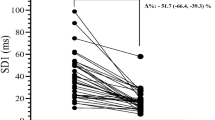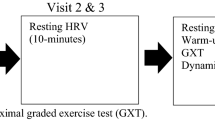Abstract
Background
Despite a growing clinical interest in determining the heart rate recovery (HRR) response to exercise, the limits of a normal HRR have not yet been well established.
Purpose
This study was designed to examine HRR following a controlled maximal exercise test in healthy, physically active adult men.
Methods
The subjects recruited (n = 789) performed a maximal stress test on a treadmill. HRR indices were calculated by subtracting the first and third minute heart rates (HRs) during recovery from the maximal HR obtained during stress testing and designated these as HRR-1 and HRR-3, respectively. The relative change in HRR was determined as the decrease in HR produced at the time points 1 and 3 min after exercise as a percentage of the peak HR (%HRR-1/HRpeak and %HRR-3/HRpeak, respectively). Percentile values of HRR-1 and HRR-3 were generated for the study population.
Results
Mean HHR-1 and HHR-3 were 15.24 ± 8.36 and 64.58 ± 12.17 bpm, respectively, and %HRR-1/HRpeak and %HRR-3/HRpeak were 8.60 ± 4.70 and 36.35 ± 6.79 %, respectively. Significant correlation was detected between Peak VO2 and HRR-3 (r = 0.36; p < 0.001) or %HRR-3/HRpeak (r = 0.23; p < 0.001).
Conclusions
Our study provides normality data for HRR following a maximal Ergometry test obtained in a large population of physically active men.



Similar content being viewed by others
Abbreviations
- BMI:
-
Body mass index
- HR:
-
Heart rate
- HRR:
-
Heart rate recovery
- HRrest :
-
Heart rate at rest
- Peak VO2 :
-
Peak oxygen uptake
- RER:
-
Respiratory exchange ratio
- VO2 :
-
Oxygen uptake
- VO2max:
-
Maximal oxygen uptake
References
Baraldi E, Cooper DM, Zanconato S, Armon Y (1991) Heart rate recovery from 1 minute of exercise in children and adults. Pediatr Res 29(6):575–579. doi:10.1203/00006450-199106010-00011
Boas EP (1931) The heart rate of boys during and after exhausting exercise. J Clin Investig 10(1):145–152. doi:10.1172/JCI100335
Borresen J, Lambert MI (2007) Changes in heart rate recovery in response to acute changes in training load. Eur J Appl Physiol 101(4):503–511. doi:10.1007/s00421-007-0516-6
Borresen J, Lambert MI (2008) Autonomic control of heart rate during and after exercise: measurements and implications for monitoring training status. Sports Med 38(8):633–646
Bosquet L, Gamelin FX, Berthoin S (2007) Is aerobic endurance a determinant of cardiac autonomic regulation? Eur J Appl Physiol 100(3):363–369. doi:10.1007/s00421-007-0438-3
Brown SJ, Brown JA (2007) Resting and postexercise cardiac autonomic control in trained master athletes. J Physiol Sci 57(1):23–29. doi:10.2170/physiolsci.RP012306
Buchheit M, Gindre C (2006) Cardiac parasympathetic regulation: respective associations with cardiorespiratory fitness and training load. Am J Physiol Heart Circ Physiol 291(1):H451–H458. doi:10.1152/ajpheart.0 0008.2006
Buchheit M, Papelier Y, Laursen PB, Ahmaidi S (2007) Noninvasive assessment of cardiac parasympathetic function: postexercise heart rate recovery or heart rate variability? Am J Physiol Heart Circ Physiol 293(1):H8–H10. doi:10.1152/ajpheart.0 0335.2007
Bunc V, Heller J, Leso J (1988) Kinetics of heart rate responses to exercise. J Sports Sci 6(1):39–48. doi:10.1080/02640418808729792
Carnethon MR, Jacobs DR Jr, Sidney S, Sternfeld B, Gidding SS, Shoushtari C, Liu K (2005) A longitudinal study of physical activity and heart rate recovery: CARDIA, 1987–1993. Med Sci Sports Exerc 37(4):606–612
Chorbajian T (1971) Normographic approach for the estimation of heart rate recovery time after exercise. J Appl Physiol 31(6):962–964
Cole CR, Blackstone EH, Pashkow FJ, Snader CE, Lauer MS (1999) Heart-rate recovery immediately after exercise as a predictor of mortality. N Engl J Med 341(18):1351–1357. doi:10.1056/NEJM199910283411804
Cooke WH, Carter JR (2005) Strength training does not affect vagal-cardiac control or cardiovagal baroreflex sensitivity in young healthy subjects. Eur J Appl Physiol 93(5–6):719–725. doi:10.1007/s00421-004-1243-x
Coote JH (2010) Recovery of heart rate following intense dynamic exercise. Exp Physiol 95(3):431–440. doi:10.1113/expphysiol.2009.047548
Darr KC, Bassett DR, Morgan BJ, Thomas DP (1988) Effects of age and training status on heart rate recovery after peak exercise. Am J Physiol 254(2 Pt 2):H340–H343
Esco MR, Olson MS, Williford HN (2010) The relationship between selected body composition variables and muscular endurance in women. Res Q Exerc Sport 81(3):272–277
Gibbons RJ, Balady GJ, Bricker JT, Chaitman BR, Fletcher GF, Froelicher VF, Mark DB, McCallister BD, Mooss AN, O’Reilly MG, Winters WL, Gibbons RJ, Antman EM, Alpert JS, Faxon DP, Fuster V, Gregoratos G, Hiratzka LF, Jacobs AK, Russell RO, Smith SC, American College of Cardiology/American Heart Association Task Force on Practice Guidelines. Committee to Update the Exercise Testing G (2002) ACC/AHA 2002 guideline update for exercise testing: summary article. A report of the American College of Cardiology/American Heart Association Task Force on Practice Guidelines (Committee to Update the 1997 Exercise Testing Guidelines). J Am Coll Cardiol 40(8):1531–1540
Goldberg DI, Shephard RJ (1980) Stroke volume during recovery from upright bicycle exercise. J Appl Physiol 48(5):833–837
Goldberger JJ, Le FK, Lahiri M, Kannankeril PJ, Ng J, Kadish AH (2006) Assessment of parasympathetic reactivation after exercise. Am J Physiol Heart Circ Physiol 290(6):H2446–H2452. doi:10.1152/ajpheart.01118.2005
Goldsmith RL, Bloomfield DM, Rosenwinkel ET (2000) Exercise and autonomic function. Coron Artery Dis 11(2):129–135
Hagberg JM, Moore GE, Ferrell RE (2001) Specific genetic markers of endurance performance and VO2max. Exerc Sport Sci Rev 29(1):15–19
Hart E, Dawson E, Rasmussen P, George K, Secher NH, Whyte G, Shave R (2006) Beta-adrenergic receptor desensitization in man: insight into post-exercise attenuation of cardiac function. J Physiol 577(Pt 2):717–725. doi:10.1113/jphysiol.2006.116426
Hautala AJ, Rankinen T, Kiviniemi AM, Makikallio TH, Huikuri HV, Bouchard C, Tulppo MP (2006) Heart rate recovery after maximal exercise is associated with acetylcholine receptor M2 (CHRM2) gene polymorphism. Am J Physiol Heart Circ Physiol 291(1):H459–H466. doi:10.1152/ajpheart.01193.2005
Heffernan KS, Fahs CA, Shinsako KK, Jae SY, Fernhall B (2007) Heart rate recovery and heart rate complexity following resistance exercise training and detraining in young men. Am J Physiol Heart Circ Physiol 293(5):H3180–H3186. doi:10.1152/ajpheart.00648.2007
Hirsh DS, Vittorio TJ, Barbarash SL, Hudaihed A, Tseng CH, Arwady A, Goldsmith RL, Jorde UP (2006) Association of heart rate recovery and maximum oxygen consumption in patients with chronic congestive heart failure. J Heart Lung Transplant 25(8):942–945. doi:10.1016/j.healun.2006.04.006
Huikuri HV, Jokinen V, Syvanne M, Nieminen MS, Airaksinen KE, Ikaheimo MJ, Koistinen JM, Kauma H, Kesaniemi AY, Majahalme S, Niemela KO, Frick MH (1999) Heart rate variability and progression of coronary atherosclerosis. Arterioscler Thromb Vasc Biol 19(8):1979–1985
Imai K, Sato H, Hori M, Kusuoka H, Ozaki H, Yokoyama H, Takeda H, Inoue M, Kamada T (1994) Vagally mediated heart rate recovery after exercise is accelerated in athletes but blunted in patients with chronic heart failure. J Am Coll Cardiol 24(6):1529–1535
Jouven X, Empana JP, Schwartz PJ, Desnos M, Courbon D, Ducimetiere P (2005) Heart-rate profile during exercise as a predictor of sudden death. N Engl J Med 352(19):1951–1958. doi:10.1056/NEJMoa043012
Kannankeril PJ, Le FK, Kadish AH, Goldberger JJ (2004) Parasympathetic effects on heart rate recovery after exercise. J Investig Med 52(6):394–401
Kirby T, Hartung GH (1980) Briefly: heart rate deceleration in conditioned and unconditioned men. Am Correct Ther J 34(6):162–163
Lamberts RP, Swart J, Noakes TD, Lambert MI (2009) Changes in heart rate recovery after high-intensity training in well-trained cyclists. Eur J Appl Physiol 105(5):705–713. doi:10.1007/s00421-008-0952-y
Maeder MT, Ammann P, Rickli H, Brunner-La Rocca HP (2009) Impact of the exercise mode on heart rate recovery after maximal exercise. Eur J Appl Physiol 105(2):247–255. doi:10.1007/s00421-008-0896-2
Martinmaki K, Rusko H (2008) Time-frequency analysis of heart rate variability during immediate recovery from low and high intensity exercise. Eur J Appl Physiol 102(3):353–360. doi:10.1007/s00421-007-0594-5
Myers J, Hadley D, Oswald U, Bruner K, Kottman W, Hsu L, Dubach P (2007) Effects of exercise training on heart rate recovery in patients with chronic heart failure. Am Heart J 153(6):1056–1063. doi:10.1016/j.ahj.2007.02.038
Nilsson G, Hedberg P, Jonason T, Lonnberg I, Ohrvik J (2007) Heart rate recovery is more strongly associated with the metabolic syndrome, waist circumference, and insulin sensitivity in women than in men among the elderly in the general population. Am Heart J 154(3):460e1–460e7. doi:10.1016/j.ahj.2007.06.025
Nishime EO, Cole CR, Blackstone EH, Pashkow FJ, Lauer MS (2000) Heart rate recovery and treadmill exercise score as predictors of mortality in patients referred for exercise ECG. JAMA 284(11):1392–1398
Ostojic SM, Markovic G, Calleja-Gonzalez J, Jakovljevic DG, Vucetic V, Stojanovic MD (2010) Ultra short-term heart rate recovery after maximal exercise in continuous versus intermittent endurance athletes. Eur J Appl Physiol 108(5):1055–1059. doi:10.1007/s00421-009-1313-1
Parekh A, Lee CM (2005) Heart rate variability after isocaloric exercise bouts of different intensities. Med Sci Sports Exerc 37(4):599–605
Perini R, Orizio C, Comande A, Castellano M, Beschi M, Veicsteinas A (1989) Plasma norepinephrine and heart rate dynamics during recovery from submaximal exercise in man. Eur J Appl Physiol 58(8):879–883
Savin WM, Davidson DM, Haskell WL (1982) Autonomic contribution to heart rate recovery from exercise in humans. J Appl Physiol 53(6):1572–1575
Seiler S, Haugen O, Kuffel E (2007) Autonomic recovery after exercise in trained athletes: intensity and duration effects. Med Sci Sports Exerc 39(8):1366–1373. doi:10.1249/mss.0b013e318060f17d
Short KR, Sedlock DA (1997) Excess postexercise oxygen consumption and recovery rate in trained and untrained subjects. J Appl Physiol 83(1):153–159
Sidney KH, Shephard RJ (1978) Frequency and intensity of exercise training for elderly subjects. Med Sci Sports 10(2):125–131
Singh JP, Larson MG, Manolio TA, O’Donnell CJ, Lauer M, Evans JC, Levy D (1999) Blood pressure response during treadmill testing as a risk factor for new-onset hypertension. The Framingham heart study. Circulation 99(14):1831–1836
Singh JP, Larson MG, O’Donnell CJ, Tsuji H, Corey D, Levy D (2002) Genome scan linkage results for heart rate variability (the Framingham Heart Study). Am J Cardiol 90(12):1290–1293
Sugawara J, Murakami H, Maeda S, Kuno S, Matsuda M (2001) Change in post-exercise vagal reactivation with exercise training and detraining in young men. Eur J Appl Physiol 85(3–4):259–263
Takahashi T, Hayano J, Okada A, Saitoh T, Kamiya A (2005) Effects of the muscle pump and body posture on cardiovascular responses during recovery from cycle exercise. Eur J Appl Physiol 94(5–6):576–583. doi:10.1007/s00421-005-1369-5
Tulumen E, Khalilayeva I, Aytemir K, Ergun Baris Kaya FE, Sinan Deveci O, Aksoy H, Kocabas U, Okutucu S, Tokgozoglu L, Kabakci G, Ozkutlu H, Oto A (2011) The reproducibility of heart rate recovery after treadmill exercise test. Ann Noninvasive Electrocardiol 16(4):365–372. doi:10.1111/j.1542-474X.2011.00464.x
Acknowledgments
This study was conducted at the installations of the OHP Medical Center, Reebok Sports Club Madrid.
Conflict of interest
The authors declare that they have no conflicts of interest.
Ethical standards
The study protocol was approved by the review board of the Universidad Complutense de Madrid and comply with the current laws of Spain.
Author information
Authors and Affiliations
Corresponding author
Additional information
Communicated by Massimo Pagani.
Rights and permissions
About this article
Cite this article
Vicente-Campos, D., López, A.M., Nuñez, M.J. et al. Heart rate recovery normality data recorded in response to a maximal exercise test in physically active men. Eur J Appl Physiol 114, 1123–1128 (2014). https://doi.org/10.1007/s00421-014-2847-4
Received:
Accepted:
Published:
Issue Date:
DOI: https://doi.org/10.1007/s00421-014-2847-4




